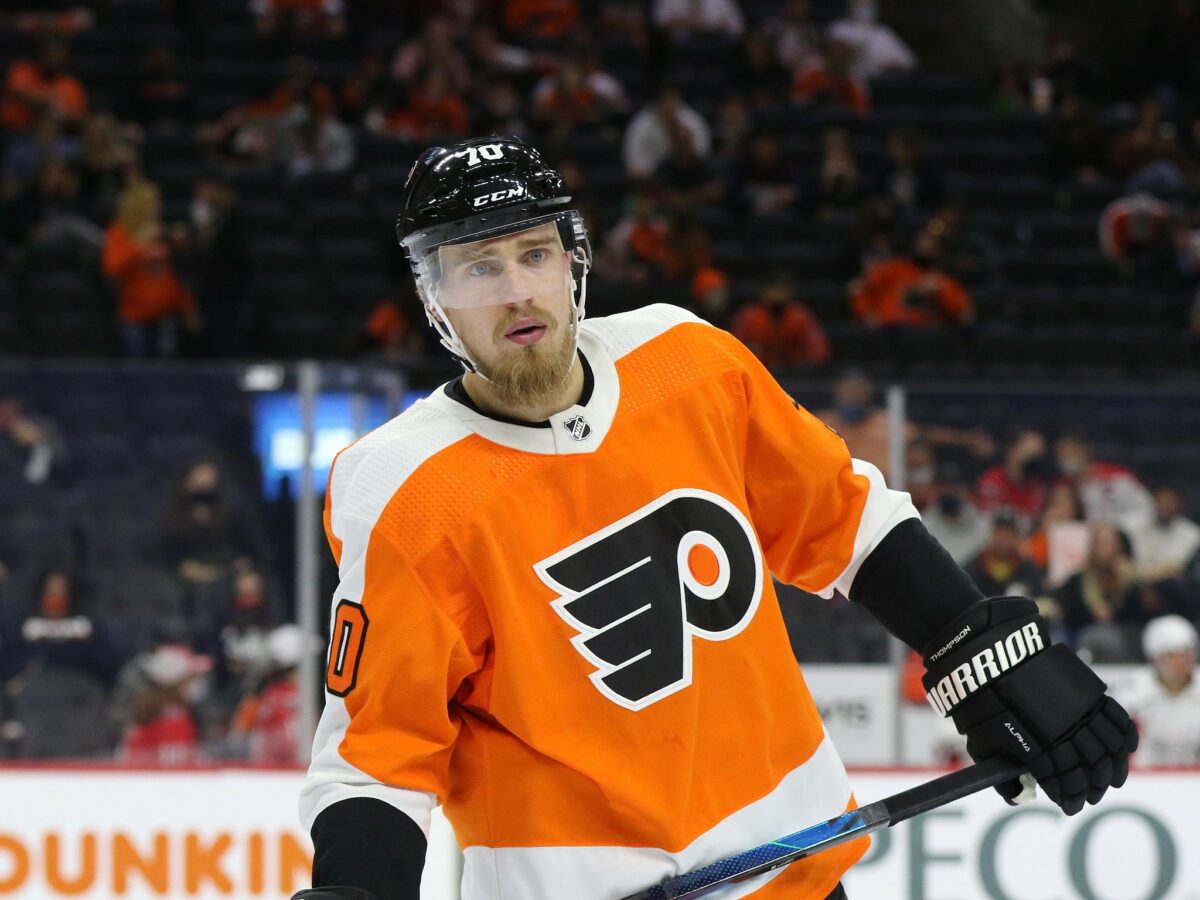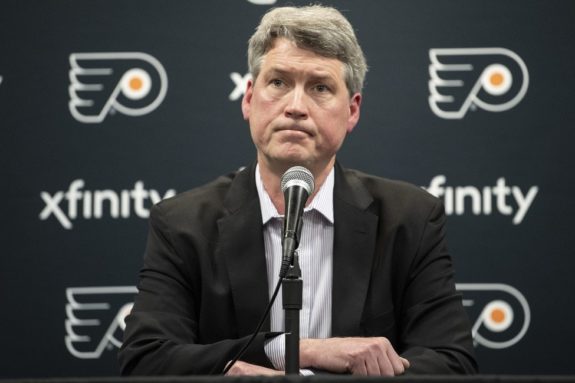Philadelphia Flyers general manager Chuck Fletcher candidly admitted he paid a big price to acquire Rasmus Ristolainen from the Buffalo Sabres during the 2021 offseason. He brought in the 6-foot-4 defenseman as part of a major roster shakeup designed to make the Flyers “harder to play against” after a disappointing 2020-21 season.
The outlook of the franchise has changed drastically since they dealt a first-round pick (14th overall in 2021), a second-round pick in 2023, and defenseman Robert Hagg in exchange for Ristolainen. The Flyers now find themselves in the midst of a nightmare season out of playoff contention, and they will explore logical options as sellers approaching the trade deadline on March 21.
Elliotte Friedman of Sportsnet wrote on Friday about the possibility of Ristolainen on the trade block.
“I think the Flyers’ Rasmus Ristolainen gets moved. He wants a playoff series. Not only do I understand the desire to finally get a chance after almost 600 games, but I could see Ristolainen thinking postseason style as beneficial for his market value.”
-Elliotte Friedman
The 27-year-old bruiser will become an unrestricted free agent (UFA) this offseason. The Flyers have expressed interest in retaining him, but a deadline deal to send him to contender is the most logical scenario for all parties involved.
Flyers Take on Ristolainen as a Project
Ristolainen came to Philadelphia with plenty of red flags. He is a skilled defenseman who plays with a physical edge, but his hockey sense and play-driving capabilities were noticeable weaknesses during his eight seasons in Buffalo. Jack Eichel, Jeff Skinner, and Sam Reinhart, three of his most talented former Sabres teammates, all suffered significant drops in Corsi For percentage (CF%), expected goals for percentage (xGF%), and actual goals for percentage when playing with Ristolainen on the ice at even strength from 2018-19 through 2020-21 (from The Athletic, Flyers go all-in on Rasmus Ristolainen: Is he worth the huge price that GM Chuck Fletcher paid?, 7/24/21).

The haul they gave up was questionable. In addition to the package sent to Buffalo, the Flyers needed to clear cap space to fit his $5.4 million salary on the final year of his contract in 2021-22. They sent defenseman Shayne Gostisbehere, a second-round pick in 2022, and a seventh-round pick in 2022 to the Arizona Coyotes for no return package just to subtract Gostisbehere’s $4.5 million salary.
The Flyers viewed Ristolainen as a reclamation project. They believed a change of scenery and more appropriate usage would help accentuate his toughness and raw talent. Fletcher spoke in November about how he expected the transition to progress throughout the 2021-22 season.
“We’re going to have to give this a couple months, and it may take time to form chemistry between the two (Ristolainen and defensive partner Travis Sanheim), and there’s going to be ups and downs like there is with everybody, and let’s just be patient.”
-Chuck Fletcher
The organization wanted to bring the player along within a sound defensive structure, and they hoped a winning environment could help him reach the potential he never found in Buffalo. However, they haven’t been able to create that environment around him during his only season in Philadelphia.
Season with Flyers in 2021-22
Ristolainen has two goals and 11 assists in 45 games with Philadelphia in 2021-22. He has spent a majority of the season with Travis Sanheim on the second defensive pairing, and his play has come as advertised with plenty of ups and downs. His selection of opportunities to pinch in the offensive zone has room for improvement, and his inability to drive play in Buffalo hasn’t miraculously corrected itself.
In an organization that has placed a heavy emphasis on becoming harder to play against, his physicality and intensity have been the focus of the compliments he’s received from prominent members of the organization. Fletcher believes that Ristolainen can “bring an element that not a lot of people have” as a right-handed defenseman with great size and a reputation as a heavy hitter.

Ristolainen spoke on Saturday about how much he enjoys playing against the Washington Capitals because of the physical style they bring. When asked about the intensity the team showed against the Capitals, he responded, “that’s how I think the game should be played.” Interim head coach Mike Yeo pointed out that it “doesn’t seem to take much to drag him into the fight.”
Fletcher didn’t intend to acquire Ristolainen as a rental player for one season. The Finnish blueliner fits the organization’s desire for “bigger, more competitive” players that add a level of intensity to the lineup. However, part of the reason he left Buffalo was to pursue a chance to play in the postseason. Indications suggest that it’s unlikely he will sign a long-term deal given the way the Flyers have struggled to contend. In addition to Friedman’s report, Jason Myrtetus emphatically referred to Ristolainen as “a guy that will get dealt” before the trade deadline.
Ristolainen’s Trade Value, Potential Destinations
The unlikelihood of Ristolainen remaining in Philadelphia brings up questions about the major haul they gave up to acquire him just over six months ago. They can recoup some of the assets in a deal before March 21. Fletcher pointed out that his big defenseman is “valued around the league from managers and coaches and scouts,” but just how valuable is he? The big defenseman plays a style perfectly suited for the playoffs, and contending teams salivate over players who provide a high level of intensity.
The best barometer for a potential return package is the trade made by the Tampa Bay Lightning to acquire David Savard ahead of last season’s trade deadline. The Columbus Blue Jackets acquired a first-round pick in 2021 and a third-round pick in 2022 in exchange for the veteran defenseman in a three-team trade. Following the acquisition, Lightning general manager Julien BriseBois spoke about the addition.
“As we were leading up to the trade deadline, we’d identified the area that we could most improve our team as being the acquisition of a top-four, right-shot defenseman. And very quickly we targeted David Savard as being the best fit for that role. We had the chance to see David play against our team during the last two playoffs runs, get to see how hard he is to play against, to see how tough he is and heavy he plays and how reliable he is defensively, and we knew that he is the type of player that you want on your team for a long playoff run.”
-Julien BriseBois
The description of a top-four, right-shot defenseman who fits the playoff mold as “hard to play against” could be easily transferred to Ristolainen. He is currently three years younger than Savard was at the time of the trade, and he possesses a better offensive skill set.

The potential drawbacks for a team looking to acquire Ristolainen were also present with Savard. The former has posted a mediocre 47.56 CF% and 47.54 xGF% at five-on-five in 2021-22 (per Natural Stat Trick). However, both numbers exceed Savard’s 44.57 CF% and 46.11% in 2020-21. Both cases include the risk of acquiring a player with an expiring contract who won’t return the following season.
Although the Lightning didn’t retain Savard, it’s hard to say they regret the move. They ultimately minimized his role during the playoffs because of the superb play on the blue line from Victor Hedman, Ryan McDonagh, Mikhail Sergachev, and Erik Černák. The dynamic helped them win their second consecutive Stanley Cup.
Related: Trade Deadline Big Board: Top 10 Targets for 2022
John Klingberg of the Dallas Star is the top right-handed defenseman, and arguably the top player, available at the trade deadline. The high bidding price for him might force some teams to look toward a secondary option like Ristolainen. The Hockey News listed the Los Angeles Kings and Nashville Predators as potential suitors for Klingberg, and either team could become a partner for the Flyers if negotiations don’t work out. Rob Couch of The Hockey Writers listed the Boston Bruins and New York Rangers in addition to the Kings as potential landing spots for Philadelphia’s 6-foot-4 bruiser.
Fletcher paid a lucrative price for Ristolainen because he believed he was acquiring a piece necessary for his team to compete. Philadelphia’s lack of success created circumstances that don’t benefit the player, but Fletcher can find a GM in a similar position in March during the height of the seller’s market. The role reversal might help him sell off an asset that didn’t mesh perfectly and recoup some or all of the value for the organization in a season that has gone off the rails. Although recently-traded players rarely return to the teams that dealt them after less than a full season away, the Flyers could in theory deal Ristolainen and also pursue him in free agency this summer.